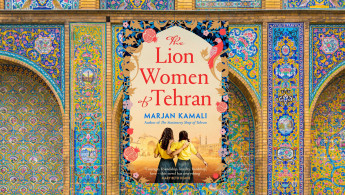Saffron, love and sisterhood in Marjan Kamali's The Lion Women of Tehran
The Lion Women of Tehran by Marjan Kamali delves into the deep friendship between two women hailing from different parts of society during extreme political turmoil.
Set against Iran's tumultuous political history from the reign of the Shah in the 1950s to the present-day fundamentalist government, the story revolves around Homa, a lifelong activist who strives for women's rights and equality and Ellie, whose family is linked to royalty.
The book traces the life trajectory of these two women with very different dreams and ideologies, yet they retain the close friendship forged during their primary school days.
Though both Ellie and Homa are committed to the rights and freedoms of women, Ellie’s often immature approach clashes with Homa’s unrestrained fight against injustice, especially where women are targeted.
In the first half of the book, the author builds up not only the strong bond between Ellie and Homa but also the tender love sprouting between Ellie and Mehrdad.
“Those eyes behind the tortoiseshell glasses for whom Homa had climbed a mountain. When she’d looked into them, she’d seen genuine goodness. She had predicted happiness for me… A fraction of possibility was opening up into a lifetime expanse.”
Even though the larger story centres around the unsettling politics playing out in the country and the surreptitious stripping of freedoms, the focus is firmly on the friendship between Ellie and Homa that threatens to collapse in the aftermath of an irredeemable mistake.
Ellie’s mother once tells her, “Even those who love you most can ruin your life… even the ones you trust the most,” never realising that her daughter would one day commit a mistake so grave which would change the course of Homa’s life.
Ellie’s love story and life of privilege add a light touch to the narrative acting as a balance to Homa's tumultuous journey filled with insistent rants and political activism that puts her on the warpath even as she studies law to become a judge.
Homa’s insistence on questioning the authorities perplexs Ellie and she cannot understand from her privileged point of view why one would want to upset the Shah’s government that allows women to study and grants them rights hitherto unseen in the country.
Even when Homa points to the human rights violations behind the veil of reforms, the nepotism and corruption rampant in the country, Ellie questions the necessity of protests.
Yet Homa preservers at great personal costs because she believes in the possibilities of change that resistance to injustice can bring about.
The author also focuses on the unique traditions and customs followed by the people of the country.
The advent of spring, Nowruz celebrations, the bustling bazaars with their busy craftspeople and fragrant spices, and house parties held in the homes of the upper class, bring alive the ethos of the land.
Descriptions of food appear at regular intervals, with references to fragrant saffron rice and kabab, the salty fizzy yoghurt drink called doogh, pomegranate molasses, salad Olivier sandwiches and much more.
Food is also used to good effect to depict diametrically opposite moods: “The air smelled like bergamot and hookah smoke and sautéed onions. A big open window at the front maximised the view”, or “The entryway smelled like fried onions and mop water. Peeling paint curled on the walls”.
The narrative is presented predominantly from Ellie’s perspective, though Homa’s perspective appears in the last section of the book.
At the heart of the narrative is the concept of shir zan or lion women, women who fight in every way possible to create better lives for themselves despite the obstacles.
This concept comes through in the stories of not only the main characters but also their mothers and friends — strong women from all sections of society who have had to fight battles and carve out acceptable spaces of life for themselves, sometimes making great personal sacrifices to ensure a better life for their children.
In beautiful prose, Kamali sketches her characters with nuanced strokes even while depicting traumatic topics with sensitivity.
Characters, whether male or female are depicted as normal people with passions and foibles that go on to upend lives, whether done forcefully or innocently.
The author addresses several important themes, including social class, feminism, women’s rights and political activism, as well as the immigrant experience and life in the United States.
Through the lives of fictional characters in the book, Kamali focuses on the increasingly closeted world of women in Iran through the decades from the Shah’s government to the present time.
Readers are also given a glimpse of the region's rich culture and tapestry of life as it was previously compared to the scenario today.
Though this is a story set in Iran, it could also be very well the story of women in different corners of the world.
Fehmida Zakeer is an independent writer and author based in Chennai, India. Her articles have been published in various Indian and international publications, including The Hindu Literary Review, The Hindu Young World, New Indian Express, Prevention, Better Homes and Garden, Women’s Feature Service, Women’s International Perspective, Azizah, Herbs for Health, and Good Housekeeping
Follow her on X: @FehmidaZakeer




 Follow the Middle East's top stories in English at The New Arab on Google News
Follow the Middle East's top stories in English at The New Arab on Google News


